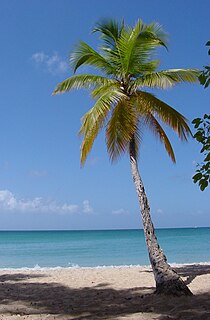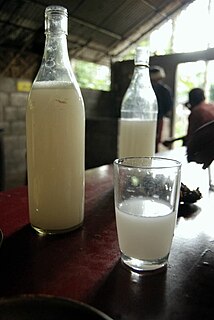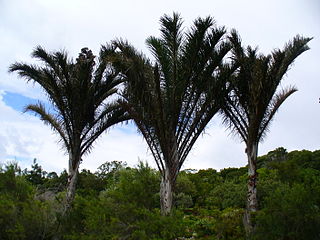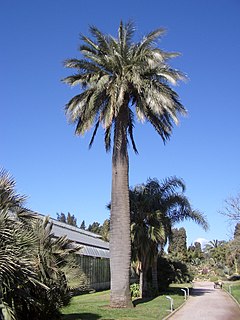
Vinegar is an aqueous solution of acetic acid and trace chemicals that may include flavorings. Vinegar typically contains 5–20%acetic acid by volume. Usually the acetic acid is produced by the fermentation of ethanol or sugars by acetic acid bacteria. There are many types of vinegar, depending upon the source materials. Vinegar is now mainly used in the culinary arts: as a flavorful, acidic cooking ingredient, or in pickling.
Palm most commonly refers to:

The Arecaceae are a botanical family of perennial plants. Their growth form can be climbers, shrubs, tree-like and stemless plants, all commonly known as palms. Those having a tree-like form are colloquially called palm trees. They are flowering plants, a family in the monocot order Arecales. Currently 181 genera with around 2600 species are known, most of them restricted to tropical and subtropical climates. Most palms are distinguished by their large, compound, evergreen leaves, known as fronds, arranged at the top of an unbranched stem. However, palms exhibit an enormous diversity in physical characteristics and inhabit nearly every type of habitat within their range, from rainforests to deserts.

Sago is a starch extracted from the spongy centre, or pith, of various tropical palm stems, especially that of Metroxylon sagu. It is a major staple food for the lowland peoples of New Guinea and the Moluccas, where it is called saksak, rabia and sagu. The largest supply of sago comes from Southeast Asia, particularly Indonesia and Malaysia. Large quantities of sago are sent to Europe and North America for cooking purposes. It is traditionally cooked and eaten in various forms, such as rolled into balls, mixed with boiling water to form a glue-like paste (papeda), or as a pancake. Sago is often produced commercially in the form of "pearls". Sago pearls can be boiled with water or milk and sugar to make a sweet sago pudding. Sago pearls are similar in appearance to the pearled starches of other origin, e.g. cassava starch (tapioca) and potato starch, and they may be used interchangeably in some dishes.

Palm Wine is an alcoholic beverage created from the sap of various species of palm tree such as the palmyra, date palms, and coconut palms. It is known by various names in different regions and is common in various parts of Asia, Africa, the Caribbean, South America, and Micronesia.

Raffia palms (Raphia) are a genus of about twenty species of palms native to tropical regions of Africa, and especially Madagascar, with one species also occurring in Central and South America. R. taedigera is the source of raffia fibers, which are the veins of the leaves, and this species produces a fruit called "brazilia pods", "uxi nuts" or "uxi pods".

Amos Tutuola was a Nigerian writer who wrote books based in part on Yoruba folk-tales.
Palm-wine music is a West African musical genre. It evolved among the Kru people of Liberia, who used Portuguese guitars brought by sailors, combining local melodies and rhythms with Trinidadian calypso. Palm-wine music was named after a drink, palm wine, made from the naturally fermented sap of the oil palm, which was drunk at gatherings where early African guitarists played.

Jubaea is a genus of palms with one species, Jubaea chilensis or Jubaea spectabilis, commonly known as the "Chilean wine palm" or "Chile cocopalm". It is native to southwestern South America and is endemic to a small area of central Chile between 32°S and 35°S in southern Coquimbo, Valparaíso, Santiago, O'Higgins, and northern Maule regions.

La Campana National Park is located in the Cordillera de la Costa, Quillota Province, in the Valparaíso Region of Chile. La Campana National Park and the Vizcachas Mountains lie northwest of Santiago. This national park covers approximately 80 square kilometres (31 sq mi) and is home to one of the last palm forests of Jubaea chilensis, which prehistorically had a much wider distribution than at present. Another attraction is the Cerro La Campana, which lends its name to the park. In 1834 Charles Darwin climbed this mountain, during the second voyage of HMS Beagle.
Lambanóg is a traditional Filipino distilled palm liquor made from coconut or nipa palm sap. It is derived from tubâ that has been aged for at least 48 hours. It originates from Luzon island in the northern Philippines. It is commonly described as "coconut vodka" due to its clear to milky white color and high alcohol content. It is particularly potent, having a typical alcohol content of 80 to 90 proof after a single distillation; this may go as high as 166 proof after the second distillation. Its smoothness has been compared to that of Japanese sake and European schnapps.

Miel de palma is an edible sweet syrup produced from the sap of a number of palms. It is produced in the Canary Islands and coastal regions of South America.

The Cuisine of Equatorial Guinea is a blend of the cuisines of the native tribes, as well as that of Spain and Islamic states such as Morocco. Its cuisine incorporates various meats, including game & bush-meat as well as imports. Fish and chicken are common dishes. As seen in the dishes here, chilies and other spices are popular. Key ingredients in Equatoguinean cuisine come from local plants and animals, including plantains, sweet potato, bread fruit, yam, cocoyam, ground-nuts and snails.

Central African cuisine includes the cuisines, cooking traditions, practices, ingredients and foods of the Central African Republic (CAR). Indigenous agriculture in the country includes millet, sorgum, banana, yam, okra, yellow onion, garlic, spinach, rice and palm oil. Imported crops of American origin include maize, manioc (cassava), peanuts, chili peppers, sweet potato and tomato. Additional foods include onions garlic, chiles and peanuts.
Bahalina, sometimes called "coconut red wine", is a traditional Filipino palm wine made from fermented coconut or nipa palm sap. It is derived from tubâ that has been aged for several months to several years. It originates from the Visayas and Mindanao islands of the southern Philippines. It is deep brown-orange in color and has a slightly bitter astringent taste.

Philippine wine or Filipino wine are various wines produced in the Philippines. They include indigenous wines fermented from palm sap, rice, job's tears, sugarcane, and honey; as well as modern wines mostly produced from various fruit crops.

Lahang is a traditional sweet and cold beverage from West Java, Indonesia, made from the sap of Arenga pinnata (aren). The drink is commonly known in Indonesia, however it is usually associated with Sundanese of West Java. It is known as a traditional isotonic drink.
Pangasi, also known as pangase or gasi, are various traditional Filipino rice wines from the Visayas Islands and Mindanao. They could also be made from other native cereals like millet and job's tears. Pangasi and other native Filipino alcoholic beverages made from cereal grains were collectively referred to by the Spanish as pitarrillos.
Agkud is a traditional Filipino fermented rice paste or rice wine of the Manobo people from Bukidnon. Agkud specifically refers to fermented three-day-old paste made with rice, ginger, sugarcane juice, and agonan or tapey. However, it can also refer to the rice wine made from agkud, since it is made with the same process except fermented longer for at least one month. Modern versions of the agkud can use other sources of starch like cassava, sorghum, or corn. Hot peppers may also be used instead of ginger. Agkud is drank during celebrations, rituals, and various social events.












